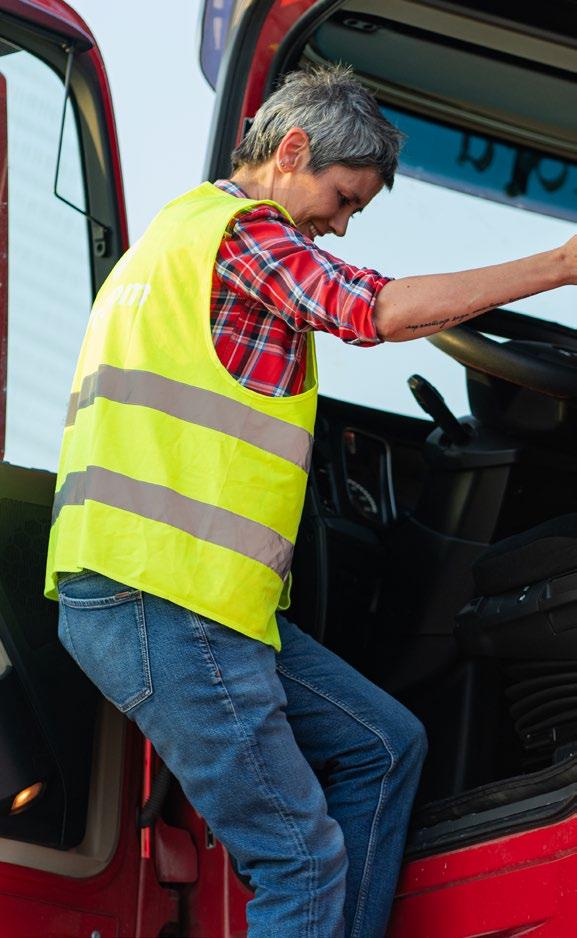Women at Work

How can employers attract more women into trucking & logistics?


How can employers attract more women into trucking & logistics?
It’s no secret that women are under-represented in the trucking and logistics industry . While the broader Canadian workforce is split fairly evenly between men and women, women make up only 16% of the trucking workforce and a mere 4% of drivers.
Yet labour force challenges persist in the industry To ensure sustainability into the future, trucking must improve its ability to reach untapped talent pools, including women Recent research by Trucking HR Canada (THRC) has shown that numerous factors influence women’s desire to work in our industry The biggest barriers to their participation are:
• An unappealing image when compared to other industries;
• Lack of awareness about the many different jobs opportunities;
• Skepticism about women’s opportunities to advance in trucking;
• On-the-job safety concerns related to harassment and other discriminatory behaviours;
• Job impacts on work-life balance and family responsibilities
As an industry, we need to provide workplaces women want to be part of The actions suggested in this Guide will help you do just that

Our research confirmed some commonsense assumptions about the qualities women appreciate in a job
Women want well-paid work that is challenging, interesting, and that offers some flexibility. They want to feel safe at work, and they want to be taken seriously and to have opportunities for professional growth They don’t want to contend with stereotypes or “boys’ club” culture
Fortunately, many of the qualities women are looking for in a job can be found in the trucking industry To attract more women to the sector, we can do a better job of communicating that, both by highlighting our strengths and addressing gaps and challenges that could be keeping people out
“I’ve had customers tell me that I do not belong in the industry. I handled it well enough and explained my background and that I can clearly do the job just as good, if not better than any man could. My company treats me equally.”
This guide links to a practical toolkit, “Checking Your Blind Spots,” to help you identify gender gaps in your workplace The Guide and toolkit can help you assess your company’s current state with respect to gender equity They also include practical tips you can implement in five key areas of your talent management strategy:
• Attracting talent to your business;
• Effective and equitable hiring;
• Retention;
• Prioritizing safety;
• Paving the way forward
Where possible, we’ve included direct links to relevant tools and templates from our HR Resource Library You can read the Guide in order or go directly to the sections that are most relevant for your company, but we recommend starting with a gap analysis
“It’s never boring, and I’m always being challenged (in a good way).”
Before introducing a new initiative or making changes to existing policies or practices, it’s important to know where you stand What’s working well and where is there room for improvement?
We are here to help you find your blind spots.
Our new gap analysis toolkit, “Checking Your Blind Spots,” includes:
• Questions to facilitate a gender equity discussion with your leadership team;
• A gender-focused SWOT analysis framework;
• Survey questions to deploy within your teams;
• Guidelines for policy implementation and review
You can access the toolkit from our HR Library We recommend using it as a starting point before diving into the later sections of this Guide

4 steps to help you get started
1 Get and Communicate Leadership Buy-In: articulate your leadership team’s commitment internally and externally;
2 Assign Responsibility: Appoint a champion or team of champions to ensure equity actions are meaningful and on-going;
3 Set Goals: Establish long-term and shortterm goals to track progress and success;
4 Seek Input: Ask for feedback from your teams on what you’re doing well and where improvement is needed

Some of these perceptions are based on assumptions and don’t accurately reflect the state of the industry today. For example, many women we surveyed associate trucking with truck drivers and aren’t aware of the other career opportunities in our sector Trucking employers can help change false or outdated narratives by highlighting the many other facets and opportunities in the industry
Your people:
Equip current employees and hiring teams with information so they can address knowledge gaps and negative perceptions as they come up and be positive spokespeople for the industry
Your brand:
Confirm what strengths and unique features you want to highlight for potential hires If you have women working for you already, showcase that success: candidates may feel more excited about job opportunities at your company if they see themselves reflected in your current workforce
Some ideas to consider:
• Feature women in social media and marketing campaigns, speaking engagements, career fairs, etc Keep track of images and campaigns that have been effective;
• Include female employees in the recruitment and hiring process whenever possible;
• Leverage web analytics to customize outreach strategies to reach more women
Don’t be afraid to look for candidates in new places and new ways Partnering with secondary and post-secondary schools is a great way to get your company’s hiring needs into the hands of people who can meet them Some fleets create scholarships for female students enrolled in relevant post-secondary programs to showcase their commitment to supporting women You can also give candidates more opportunities to come to you by being active in your community and hosting events Consider hosting an open house to engage local talent and educate people about your company and the role the trucking industry plays in the community and the Canadian economy
Diversify your referral programs: communicate to your staff that you’re keen to hire more women and people from diverse backgrounds
Sweeten the pot with signing bonuses and comprehensive benefits. Our research has shown that good pay and good benefits are top priorities for women in the job market — as they are for men In most markets, attracting top talent will require thoughtful and competitive compensation packages For ideas about how to enhance and communicate your company’s offerings, check out our Best Practice Guide on Compensation

Review your recruitment process to ensure key messaging is gender neutral Look out for male pronouns and traditionally masculine descriptions in company career documents as these can send an unintended message that the jobs aren’t meant for women Including a Diversity, Equity, and Inclusion statement in hiring documents is considered a best practice If your company hasn’t developed one yet, you might find our Diversity, Equity, and Inclusion Guide a helpful resource
Keep an open mind when interviewing candidates Evaluate transferable skills and aptitudes in addition to industry-specific work experience. Candidates from underrepresented groups may have credentials or resumes that differ from what you’re used to seeing, but that doesn’t mean they aren’t a good fit for the job.
• Skills-based hiring was a leading HR trend among 2023’s Top Fleet Employers Check out THRC’s 2023 Best Practice Report to learn more
Studies have shown that women are more likely than men to underestimate their own qualifications. If they don’t tick every box in a job posting, they may not apply Employers can avoid missing out on skilled candidates by proactively assessing job requirements to ensure they are fair and reasonable
Companies with sufficient HR capacity should consider adopting a continuous recruitment approach Continuous recruitment means encouraging potential candidates to interview with your company even when there isn’t an immediate opening that matches their experience and skill set. With this approach, you can proactively connect with interested candidates to assess their skills, experience, and interests, and inform them of the many benefits of working in the industry.
Recruit internally whenever possible Give the women in your company reasons to stay and ways to grow their careers Make job postings available to everyone in the company Implement 1:1 meetings between employees and their manager and/or an HR Representative to discuss challenges and successes individuals are experiencing with the intention to remove barriers and promote growth
Our research shows that safety at work is a top priority for women, no matter how many years they’ve spent in the industry Seasoned veterans see gaps that still need to be addressed, and newcomers worry about what it will be like to work in a male-dominated industry that hasn’t traditionally accommodated women Companies of all sizes and structures can play a role in addressing safety concerns and creating an industry women want to work in
• Establish an open dialogue with employees. They know better than anyone else what it’s like to do their job Women in your company may have encountered safety threats that fly under the company’s radar
• Examine roles you want more women to apply for. Consider a truck driver role, for instance: walk through the route, starting at the loading dock Are there any potential hazards that might have been overlooked? Consider the cab of the truck: entry, exit, and comfort while driving How can this be a better environment or more comfortable for women? Consider the stops along the way: what are the perceived risks or dangers and how can the company address those? This process will provide a clear understanding of where problems (perceived and real) exist so that you can take steps to address them
• Highlight technological advancements, especially for positions where women are on the road or working alone. Examples include installing cameras on trucks and in remote spaces, using GPS or fleet management software, providing lifts in the yard to help with lifting or to provide easier access to trucks While these may require some financial planning and, in some cases, significant investment, ultimately they benefit everyone at the company.
• Harassment and sexual harassment are concerns for many women If your company is federally regulated, you should be compliant with Work Place Harassment and Violence Prevention Regulations—but there are additional steps you can take beyond compliance to discourage unwanted behaviours and ensure employees feel safe Send a clear message to all employees that no form of harassment will be tolerated Be aware of practices that could make the
workplace less comfortable for women, even if they do not target a specific individual — sexist jokes, for example, or posters and calendars that depict women in a sexualized way. See THRC’s Workplace Harassment and Violence Prevention page for more on this topic
• Are female employees expected to take on extra work that is not part of their job description, such as note-taking, or organizing social events? Make sure to ask male employees to help with these tasks too, so the activities don’t become an expectation and a burden for female employees
Remember that employees’ sense of safety is connected to overall wellbeing Social connections, physical health, psychological safety, and occupational demands all play a role in wellbeing Conducting a wellness survey with employees can help you understand the specific needs and concerns of your employees See THRC’s Wellness Survey Template
TIP: By inviting participants to self-identify their gender, you can analyze the results to see if there are differences in the experiences of men and women.
To demonstrate your company’s commitment to employee wellness and safety, we recommend keeping a log of actions the company has taken or plans to take and making that log accessible to employees
Feature big items in team meetings and company newsletters Proactively share your safety and wellness initiatives with female candidates you are interviewing If you don’t already have one, consider establishing a standing wellness committee to review and plan initiatives

We spoke to women in and outside the industry about what they look for in a job, and we kept hearing the same things: women—like many men—want good pay, job security, and interesting work They also care about work/life balance and opportunities for career growth
Consider the following approaches to strengthen retention:
Evaluate the competitiveness and fairness of your company’s compensation and benefit programs. Implement processes to ensure women have a fair shot at promotion opportunities If “leadership” is a quality your company rewards, how do you define it? Are employees rewarded for being confident and authoritative? What about those who lead through empathy and good communication? Be mindful of gender biases that can shape your perceptions of leadership and other important qualities
Quantity vs. quality of work: Women are still disproportionately responsible for child and elder care in our society, which can impact the number of hours they log at work But if they are producing high-quality results and using their time efficiently, family responsibilities shouldn’t limit their ability to advance Check out THRC’s Best Practice Guide for ways to approach performance appraisal as fairly as possible
Keep records of employee promotions so you don’t lose sight of who’s being rewarded and who isn’t
Flexible work programs, such as remote work, job sharing, and part-time arrangements are great ways to accommodate employees’ work/ life balance needs While not every role can be adapted in these ways, many can Keep an open mind about what’s possible, as flexibility can be a powerful retention tool THRC has a guide on flexible work practices that may give you some ideas about what’s possible in your workplace
Family focused policies make life easier for employees with children Talk to local childcare and eldercare providers and develop partnerships that help employees meet caregiving responsibilities Maintain and post the list of providers so employees have access when needed If possible, consider a subsidy program to help alleviate costs associated with caregiving
Women we spoke to had many positive things to say about their experiences in the trucking industry, but they also acknowledged a persistent “boys’ club” culture that makes it harder to earn the respect they deserve and grow their careers Employers who demonstrate that they are taking steps to build a more inclusive culture and lift women and other diverse employees into senior roles will be more attractive to under-represented talent
Career pathing is critical. Ensure managers are equipped to discuss career development possibilities with employees This will encourage all employees to feel more invested in the work they do for your company, and it may have a more significant effect on diverse employees — including women — for whom the path to senior positions is not as well established as it is for others If they don’t see people like themselves in the company’s current leadership, it can make a big difference when they see their managers envisioning ways to get them there Consider documenting the career-pathing process with formal evaluations and goal-setting exercises to support accountability If possible, dedicate time and funds to support training and development to help employees reach their career goals
See THRC’s Individual Development Plan tool
Consider investing in formalized development programs. These programs combine in-class or online training with work experiences that prepare employees to advance into specific roles Traditionally, they focus on leadership, but you may also identify opportunities in other specialized areas A structured training program that prepares employees for new roles increases confidence and mitigates self-doubt that could be holding talented individuals back — a key factor when it comes to gender equity, since women are more likely than men to underrate their own abilities Structured training and advancement programs can be a great way to increase the representation of women in roles or departments where they are underrepresented
Take every opportunity to develop female employees’ potential so that they are equipped to take on leadership roles as they gain more experience in the industry. Mentorship programs are a proven way to foster diverse talent Pairing junior employees with experienced female professionals can help showcase the opportunities available to women in the industry and ensure mentees get advice on how to navigate the challenges that come with being a woman in a maledominated field. Men can be great mentors for women too, provided they have the right characteristics and adequate training on how to provide appropriate support to female mentees Smaller employers might consider joining forces with peers to create formal mentor networks and share training resources
Check out THRC’s Toolbox for Mentoring Women in Canada’s Trucking Industry
Celebrate women’s achievements at your company. This could take the form of a shout-out in a team meeting, a small token of appreciation, or a more formal program for recognizing and rewarding achievements
THRC’s Top Fleet Employer program has a special award celebrating employers who take a leadership role in advancing women’s achievements. Learn more about our awards here.
Commemorate International Women’s Day. You could host a lunch, send a companywide email, or share profiles of inspirational women to show how much you value the contributions women make to your business and community Or, join THRC in celebrating women’s contributions to the trucking industry at our annual Women with Drive Leadership Summit, held each year Check out our Events page to see what we have planned next.

Funding for this project is made possible thanks to the federal Women and Gender Equality Canada (WAGE) program.